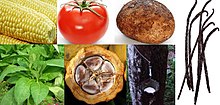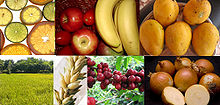Columbian exchange: Difference between revisions
m Reverted edits by 75.190.166.58 (talk) to last version by 204.194.168.227 |
Kaanatakan (talk | contribs) |
||
| Line 90: | Line 90: | ||
* [[flax]] |
* [[flax]] |
||
* [[garlic]] |
* [[garlic]] |
||
| ⚫ | |||
* [[hazelnut]] |
* [[hazelnut]] |
||
* [[hemp]] (including [[cannabis]]/marijuana) |
* [[hemp]] (including [[cannabis]]/marijuana) |
||
| Line 141: | Line 142: | ||
* [[Annona reticulata|custard apple]] |
* [[Annona reticulata|custard apple]] |
||
* [[guava]] (common) |
* [[guava]] (common) |
||
| ⚫ | |||
* [[huckleberry]] |
* [[huckleberry]] |
||
* [[Jerusalem artichoke]] |
* [[Jerusalem artichoke]] |
||
Revision as of 06:02, 15 April 2012

The Columbian Exchange was a dramatically widespread exchange of animals, plants, culture, human populations (including slaves), communicable disease, and ideas between the Western and Eastern Hemispheres. The contact between the two areas circulated a wide variety of new crops and livestock which supported increases in population in both hemispheres. Explorers returned to Europe with maize, potatoes, and tomatoes, which became very important crops in Eurasia by the 18th century. Similarly, Europeans introduced manioc and the peanut to tropical Southeast Asia and West Africa, where they flourished and supported growth in populations on soils that otherwise would not produce large yields.
Influence

In the biological and ecological exchange that took place following Spanish establishment of colonies in New World, people of Europe and Africa settled in the New World, and animals, plants and diseases of Eurasia and the Western Hemisphere were introduced to each area in an interchange.
This exchange of plants and animals transformed European, American, African, and Asian ways of life. New foods became staples of human diets, and new growing regions opened up for crops. For example, before AD 1000, potatoes were not grown outside of South America. By the 1840s, Ireland was so dependent on the potato that a diseased crop led to the devastating Irish Potato Famine.[1] Since being introduced by 16th-century Portuguese traders, who brought them from the Americas,[2] maize and manioc replaced traditional African crops as the continent’s most important staple food crops.[3] New staple crops that were introduced to Asia from the Americas via Spanish colonizers in the 16th century, including maize and sweet potatoes, contributed to the population growth in Asia.[4]
One of the first European exports, the horse, changed the lives of many Native American tribes on the Great Plains, allowing them to shift to a nomadic lifestyle based on hunting bison on horseback.[5] Tomato sauce, made from New World tomatoes, became an Italian trademark and tomatoes were widely used in France, while coffee from Africa and sugar cane from Asia became the main commodity crops of extensive Latin American plantations. Introduced to India by the Portuguese, chili/paprika from South America is today an integral part of Indian cuisine, as are potatoes.

Before the Columbian Exchange, there were no oranges in Florida, no bananas in Ecuador, no paprika in Hungary, no tomatoes in Italy, no potatoes in Germany, no coffee in Colombia, no pineapples in Hawaii, no rubber trees in Africa, no cattle in Texas, no donkeys in Mexico, no chili peppers in Thailand and India, and no chocolate in Switzerland. The dandelion was brought to North America by Europeans for use as an herb.

Of the world's top 20 crops, measured by weight of production in 2007, five (maize, potato, cassava, tomato and sweet potato) originated in the Americas while a sixth, grapes, is most commonly a European plant grafted onto an American rootstock.[6] The remaining Old World-origin agricultural commodities in the top twenty are all grown throughout the world today (cow milk, soybeans, wheat, sugar beet, sugar cane, rice, oranges, onions, sorghum, hen eggs, barley, lettuce, chicory and apples). One-half of the top crops by weight within the United States depends on foods that were first grown in the Americas (but only 39% by value).[7]
Before regular communication had been established between the two hemispheres, the varieties of domesticated animals and infectious diseases that jumped to humans, such as smallpox, were strikingly larger in the Old World than in the New. Many had migrated west with animals or people, or were brought by traders from Asia, so diseases of two continents were suffered by all. While Europeans and Asians were affected by the Eurasian diseases, their endemic status in those continents over centuries caused many people to acquire immunity. By contrast, "Old World" diseases had a devastating impact on Native American populations because they had no natural immunity to the new diseases. The smallpox epidemics are believed to have resulted in the largest death tolls among Native Americans, surpassing any wars.[8]
Examples
| Type of organism | Old World to New World | New World to Old World |
|---|---|---|
| Domesticated animals |
|
|
| Domesticated plants |
|
|
| Infectious diseases |
Unintentional introductions
Plants that arrived by land, sea, or air in "ancient" times (or before 1492 in the U.K.) are called archaeophytes, and plants introduced to Europe after those times are called neophytes. In addition to the diseases mentioned above, many species of organisms were introduced to new habitats on the other side of the world accidentally or incidentally. These include such animals as brown rats, earthworms (apparently absent from parts of the pre-Columbian New World), and zebra mussels, which arrived on ships.[9]
Invasive species of plants and pathogens also were introduced by chance, including such weeds as tumbleweeds (Salsola spp.) and Wild oats (Avena fatua). Some plants introduced intentionally, such as the Kudzu vine introduced in 1894 from Japan to the United States to help control soil erosion, have since been found to be invasive pests in the new environment. Fungi have been transported, such as the one responsible for Dutch elm disease, killing American elms in North American forests and cities, where many had been planted as street trees. Some of the invasive species have become serious ecosystem and economic problems after establishing in the New World environments.[citation needed] Note that most of these detrimental invasions were from the Eastern Hemisphere to the Western.
A beneficial, although probable unintentional, introduction is Saccharomyces eubayanus, the yeast responsible for lager beer now thought to have originated in Patagonia.[10]
Introduced feral populations
Escaped and feral populations of non-indigenous animals have thrived in both the Old and New Worlds, often displacing native species.
Gray squirrels have been particularly successful in colonising Great Britain and populations of raccoons can now be found in some regions of Germany, the Caucasus and Japan. Fur farm escapees such as coypu and American Mink have extensive populations in the Old World.
In the New World, populations of feral European cats, pigs, horses and cattle are common.
See also
- Alfred Crosby
- Domestication
- Great American Interchange
- Guns, Germs, and Steel
- Population history of American indigenous peoples
- Pre-Columbian trans-oceanic contact
- Transformation of culture
- 1493: Uncovering the New World Columbus Created
- 1491: New Revelations of the Americas Before Columbus
References
- ^ "The Impact of the Potato", History Magazine
- ^ "Super-Sized Cassava Plants May Help Fight Hunger In Africa", The Ohio State University
- ^ "Maize Streak Virus-Resistant Transgenic Maize: an African solution to an African Problem", Scitizen, August 7, 2007
- ^ "China's Population: Readings and Maps", Columbia University, East Asian Curriculum Project
- ^ This transfer reintroduced horses to the Americas, as the species had died out there prior to the development of the modern horse in Eurasia.
- ^ Top Production - world - 2007, UN Food and Agriculture Organization Template:WebCite
- ^ Top Production - United States of America - 2007, UN Food and Agriculture Organization Template:WebCite
- ^ "The Story Of... Smallpox – and other Deadly Eurasian Germs", Guns, Germs and Steel, PBS Template:WebCite
- ^ Hoddle, M. S. "Quagga & Zebra Mussels". Center for Invasive Species Research, UC Riverside. Retrieved 2010-06-29.
- ^ Elusive Lager Yeast Found in Patagonia, Discovery News, Aug 23, 2011
External links
- The Columbian Exchange: Plants, Animals, and Disease between the Old and New Worlds in the Encyclopedia of Earth by Alfred W. Crosby
- Worlds Together, Worlds Apart by Jeremy Adelman, Stephen Aron, Stephen Kotkin, et al.
- New study blames Columbus for syphilis spread from Reuters Jan 15, 2008
- Foods that Changed the World
- The Columbian Exchange study guide, analysis, and teaching guide
- NBC News piece on Columbian Exchange
Further reading
Crosby, Alfred (2003). The Columbian Exchange: Biological and Cultural Consequences of 1492. Westport, Conn.: Praeger. http://www.worldcat.org/title/columbian-exchange-biological-and-cultural-consequences-of-1492/oclc/492569775&referer=brief_results

